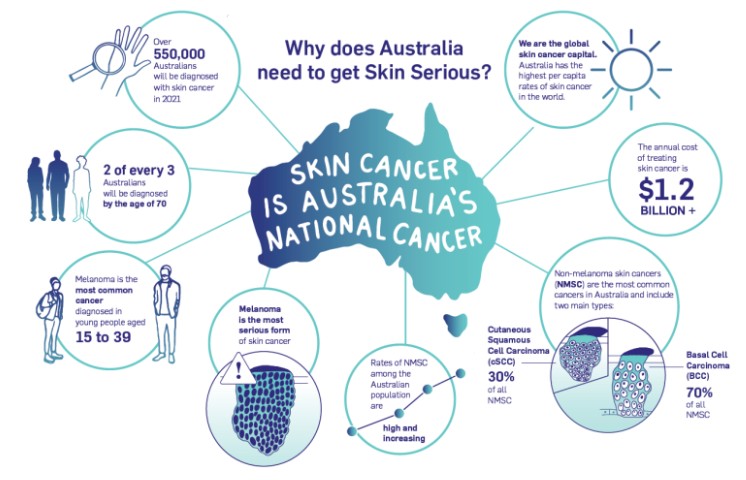Facts & Figures:
- 2 of every 3 Australians will be diagnosed by the age of 70
- Melanoma is the most common cancer diagnosed in young people aged 15 to 39
- Melanoma is the most serious form of skin cancer
- Non-melanoma skin cancers are the most common cancers in Australia and include two main types: Cutaneous Squamous Cell Carcinoma (cSCC) – 30% of all non-melanoma skin cancers & Basal Cell Carcinoma (BCC) – 70% of all non-melanoma skin cancers
- The annual cost of treating skin cancer is $1.2 billion +
- We are the global skin cancer capital. Australia has the highest per capita rates of skin cancer in the world
Prevention:
The best way to reduce your risk of skin cancer is to protect your skin from the sun and other sources of ultraviolet (UV) rays.
Early detection:
- Most skin cancers that appear on the skin can be seen with the naked eye. The best way to find them is to self-examine your skin regularly, with a complete head-to-toe skin
- See a GP or dermatologist for a comprehensive skin exam before you begin self-exams so that a baseline of “normal” can be established. From that point on, you can watch for changes.
- When you check your skin, note your mole patterns, freckles, and other spots. Take photos, which will help you notice changes over time.
- You will need a full-length mirror, a hand-held mirror, a hair dryer, a chair to sit on, and a well-lit area.
- Since you will need to remove all clothing, a good time to do your exam is prior to a shower or bath.
- Since some parts of your body, such as your back and your scalp, are difficult to see, ask your partner, family member or friend to help.
- In men, melanoma is most often found on the torso, head, and neck.
- In women, melanoma is most often found on the lower legs and torso.
Role of photography:
With the advent of smartphones, digital photography is now on everyone’s fingertips. Having a record of change through photographs may help a doctor to understand if a mole is new or changing, which are all potential signs of melanoma.
Change tends to occur month by month.
You can then take these photographs to a GP or dermatologist when you have concerns about a particular spot or when it is time for you to have a skin check.
A photographic record is particularly helpful if you have a lot of moles on your skin and if there is a family history of melanoma. Having such photographs can also assist in reducing the number of unnecessary mole removals because, if the mole or spot in question has not changed over several years, it is unlikely to be a skin cancer at the time it is being checked against the photograph.

